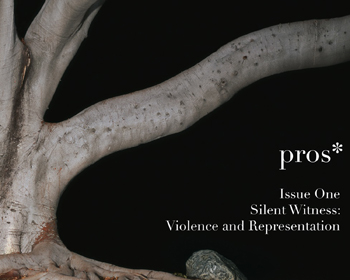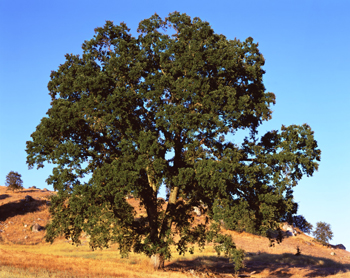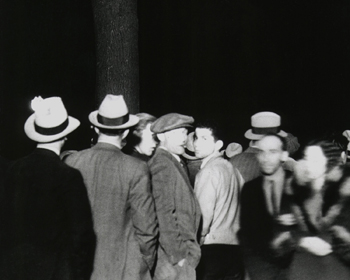Silent Witness: Gonzales-Day Work on View at the University Art Gallery
Journal and Panel Discussion Complement the Exhibition Exploring History of Lynchings
Sheena Ghanbari | April 11, 2011

Nightfall II, 2006, from "Hang
>Trees," Ken Gonzales-Day, light jet print, courtesy of the artist. Cover
design by Chuck Miller
The denial of suffering is a prevalent theme in Ken Gonzales-Day’s research and art practice. His photographs showcase historical western lynching sites, but this dark subject matter is not obvious at first glance because his pieces do not include bodies of the victims. The artist explains that “the missing body is about not wanting to re-victimize these people.” Gonzales-Day explores the history of lynchings in a solo exhibition currently on view at the UC San Diego University Art Gallery (UAG) until May 20, 2011.
“Silent Witness: Recent Work by Ken Gonzales-Day” was curated by Visual Arts Chair Grant Kester, doctoral student Elize Mazadiego and undergraduate student Jenn Moreno specifically for the UAG. The exhibit features Gonzales-Day’s two most recent bodies of work, “Erased Lynchings” and “Searching for California Hang Trees.”
Complementing the exhibition are the launch of pros* journal Issue One, “Silent Witness: Violence and Representation,” and an April 14 panel discussion, “The Fruit of Sorrow: A Dialogue on Violence and Representation.”
“Erased Lynchings” is a collection of enlarged postcards and photographs where the lynch victims have been removed from the image, while the rest of the scene remains intact. The original images were created to commemorate and publicize lynchings; these images became so pervasive that the U.S. Postal Service had to ban their circulation in 1908. Lynchings were often seen as festive occasions and a form of entertainment, especially in smaller rural communities, so these images frequently included enthusiastic crowds of on-lookers.

Golden Chain by Ken Gonzales-Day, 2005, from "Hang Trees," light jet print
In “Searching for California Hang Trees,” Gonzales-Day located a series of surviving lynch trees, or trees in close proximity to confirmed lynching sites, in the California countryside and produced large-format color landscape photographs of them. The repressed violent history of the region lies beneath the seemingly banal natural imagery. Gonzales-Day uses a large format Deardorff camera to respond to the history of landscape photography in California, which is “generally imagined to be an empty space barren land that was just there for our aesthetic pleasure.” He strives “to create a conceptually driven project that would look an awful lot like traditional landscape photography, but would try to do something more.”
pros* Issue One—a journal founded and edited by doctoral students in visual arts—stages a series of conversations that center around Ken Gonzales-Day’s photographic series, “Searching for California Hang Trees” and “Erased Lynchings,” in an effort to continue a dialogue around racial violence, history, representation and UC San Diego’s own participation in remembering and forgetting such trauma. The dialogue begins with an interview between Ken Gonzales-Day and the exhibition’s curatorial team and then extends out to a number of diverse voices in the form of text and image. Issue One features contributions from Shane Anderson, Crystal Campbell, Tania Jabour, Diana McClure, Omar Pimienta and Steve Ruiz.
The conversation around “Silent Witness” continues with a panel discussion on Thursday, April 14 at 6:30 p.m.: “The Fruit of Sorrow: A Dialogue on Violence and Representation.”

East First Street (St. James Park) by Ken Gonzales-Day, 2006, from
"Erased Lynchings," light jet print
In addition to Gonzales-Day, the panel includes Luis Alvarez of the UCSD history department, Luis Martín-Cabrera of the UCSD literature department, and Cauleen Smith of the visual arts department. The event will begin with introductory remarks by Gonzales-Day, discussing his projects currently on display in the UAG. Following this introduction, the participants will engage in an extended conversation on the issues raised by Gonzales-Day’s work, their historical significance and their resonance on the UCSD campus today. The dialogue will be moderated by Grant Kester, chair of visual arts and the director of the UAG.
The exhibit, publication and talk create an opportunity for further discussion about hateful incidents on university campuses and about the relationship between action and symbolic speech. Gonzales-Day reminds us that the act of witnessing is never innocent.
For more information about the University Art Gallery, please visit http://uag.ucsd.edu.

|